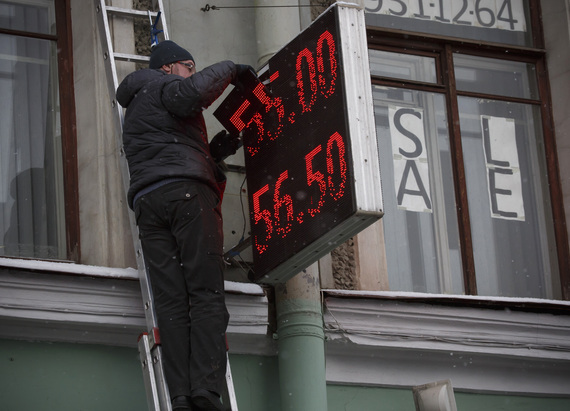Co-authored by William Witenberg a contemporary artist focused on abstract painting
Western media appears surprised that President Putin's latest approval rating was so high. After Russian military began bombing in Syria, Putin's popularity skyrocketed to its all times high of 90%. There are some obvious reasons for this, and quite a few important factors that western media tends to overlook.
Putin's recipe for achieving and keeping such high approval score is straight forward and simple. Russian media is filled with pro-Putin views; reminding citizens, that in the 90's Russia was in chaos, and Putin fixed it. The Kremlin makes sure there is no opposition, nobody else but Putin is in the limelight, and since Russian people want a strong leader, the result is the Putin's total domination.
Vladimir Putin's anti-weststern aggressiveness has gotten a slang nickname - the NEVSKY syndrome (in comparison with a Russian ruler Alexandr Nevsky who is a patron Saint of Russia, known for preserving "Russian national identity and Orthodoxy" against West's nefarious plans for weakening the country). The slang name was born as a result of Russia's fierce support of Crimea last year, and to say it in the most diplomatic manner "controversial" involvement in Ukrainian crisis.
This year the Western Press is less interested in either Crimea or Ukraine. Nobody assumes that Crimea will ever be returned to Ukraine. Putin's involvement in Syria is not meant to take over Syria rather to maintain Assad and destroy ISIS. This year, however, the main focus of Putin's attention seems to be gravitating towards strengthening of the local economy. In Russia they call it the STOLYPIN syndrome - named after a progressive reformist Russian interior minister, who is often mentioned by Putin as sort of a role model on "dealing" with Russia's internal challenges. Overall, this year Putin is expressing determination to push forward long awaited internal reforms to uplift the struggling economy. He has a very good reason for this refocusing.
Let's look at some of the current economic trends in Russia: one of the most interesting trends is related to inflation and new government approach to the ruble. Historically Russian economy collapsed or came into a major crisis as a result of the weakening of the ruble. The collapsing economy historically has resulted in a spiral of inflation, and panic of the average citizen. For years Russia supported strong ruble, financing it through Federal Reserve whenever needed. Now, since last December, regardless of the sanctions and oil prices the weakened ruble has not caused a panic, only mild inflation fear and ATM cues for a short period of time. Weak rubble is a new reality, which the Russian government may not like but seems to be adjusting to. Weak ruble has benefits which are not to be underestimated. Weaker ruble is very good for internal economy, as it allows Russia to cut its deficit and promotes GDP growth, especially in manufacturing and farming sectors. The new currency-industrial strategy went even further: even if oil prices rise, Russian government will not let ruble rise with them, intentionally keeping national currency weak.
Another major trend is export substitution. Russia used to import 50% of its food supplies and agriculture; about 57% of medicine and pharmaceuticals; manufacturing, machinery, defense, oil field services and auto parts industries were all dependent on imports. In the new Russia more food is being grown and it can reverse the enormous underdeveloped agricultural potential of the country. Chinese businesses are coming into the economy offsetting the effects of the sanctions.
Last but not least, we can clearly notice the present state of government economic dominance in Russia. The situation is at its worst since the Soviet Union period; currently about 60% of enterprises in Russia are majority owned by the state. They are ineffective and in many cases too big to be profitable, so in the light of current financial situation many enterprises default on their debt payments. On top of that, current generation of workforce is projected to decrease by 15% in the next 10 years, due to the gap of workforce formation during "perestroika" in late 80's and early 90's. Government officials do admit that the country is in an urgent need of privatization, as well as labor reform. But so far it has only been words and very little action.
To draw some conclusions of the local state of affairs in Russia: the country economically is now contained at the bottom, and it needs proactive government actions for the economy to lift back up. Even if so the recovery will be quite slow, so no expectation of "V" bounce. Putin seems to be determined to do all it takes, but as a well know Russian joke goes; "Russia isn't dangerous by its Plans it is dangerous by its Improvization."
